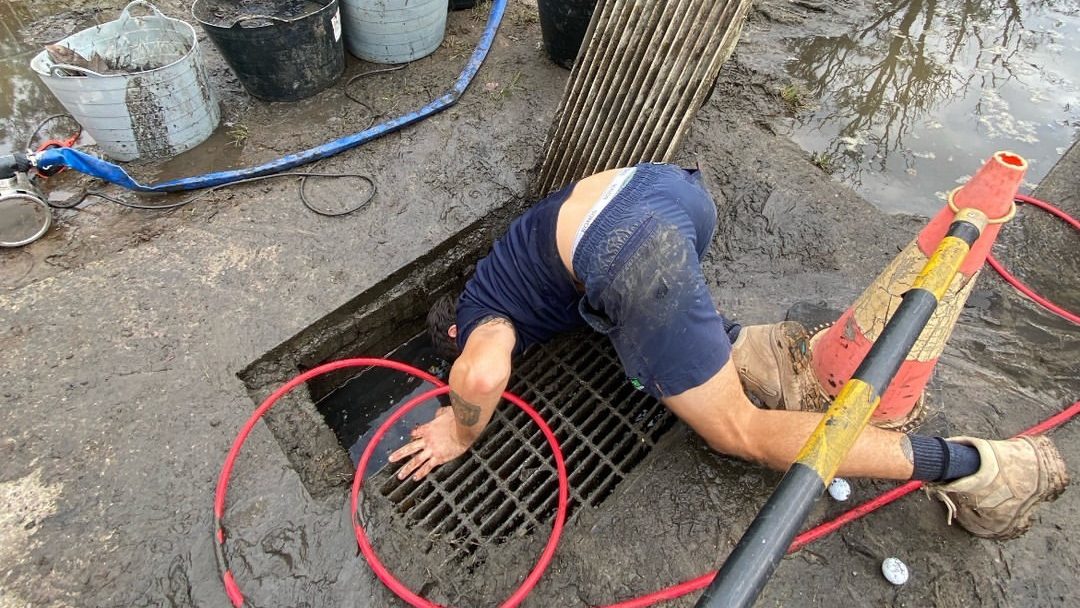
If you’re living in Sydney, especially anywhere in the Eastern suburbs, Inner West, St George or Sutherland Shire, you’ve probably noticed how our beautiful harbour city can get hit with a fair bit of rain each year. That’s where stormwater drainage comes in – it’s a crucial part of our urban infrastructure that keeps our streets from turning into waterways every time it buckets down.
At PML Plumbing, we’ve been Sydney plumbers for over a decade, so if you want the answer to the question, “What is stormwater drainage?”, we can help! Here’s the lowdown on this important topic.
What Is Stormwater?
Let’s start with the basics and consider what “stormwater” refers to. Stormwater is essentially any water that falls from the sky during rain events or storms. But it’s not just the rain itself – it’s also the water that runs off your roof, down your driveway, and across our streets and parks. Unlike the water that goes down your sink or loo, stormwater isn’t treated before it makes its way back to our waterways.
Where Does Stormwater Go?
If you’ve ever wondered where all that water disappears to after a massive downpour, here’s the journey it takes:
- First stop: The water hits our urban surfaces (roads, roofs, footpaths, etc.)
- Then it flows into street gutters and drains
- From there, it enters a network of underground pipes and channels
- Finally, it makes its way to local waterways like Botany Bay, Port Hacking, Sydney Harbour and local creeks and rivers
For those of us in the Bayside area, most of our stormwater eventually finds its way into Botany Bay or the Georges River, while Eastern suburbs residents might find their stormwater heading towards Sydney Harbour.
Types of Stormwater Drainage Systems
In Sydney and around the Bayside area, there are several different types of drainage systems in place to manage stormwater. Here are the main ones you’ll spot around our city:
Surface Drainage (Closed Stormwater Drainage Systems)
- Street gutters and channels
- Swales (shallow, wide channels or ditches that move water away from problem spots; often lined with rocks or vegetation to slow water down and encourage it into the soil)
- Kerb and gutter systems along our roads
- Surface drains in your backyard
Underground Systems (Subsurface Stormwater Drainage Systems)
- Stormwater pipes (a series of pipes installed underground to collect water that’s absorbed into the soil)
- Box culverts (precast concrete structures that allow water to flow under roads, railways, etc.)
- Detention basins (store stormwater for short periods and slowly release it into the environment or treatment systems to prevent flooding from too much water getting released at a time)
- Infiltration systems (they capture stormwater and control its release back into ground water sources without overwhelming the stormwater infrastructure)
Water Sensitive Urban Design (WSUD)
WSUD projects help reduce the quantity and improve the quality of stormwater runoff, protect and restore creeks and rivers, boost wildlife habitats, and improve the appearance of parks and streets, among other things. These are the newer, more environmentally-friendly systems you might have noticed popping up around Sydney and include things like:
- Rain gardens
- Bioretention basins
- Constructed wetlands
- Permeable paving
- Rainwater tanks
- Swales

Why Proper Stormwater Drainage Matters
For those of us living in low-lying areas like parts of Sydney, in particular, proper stormwater drainage solutions aren’t just nice to have but an essential element. Here’s why it’s such a vital aspect of our communities:
- Prevents flooding of and water damage to homes and businesses
- Reduces erosion in our local parks and reserves
- Protects our beautiful beaches and waterways from pollution
- Helps maintain our road infrastructure
- Keeps our famous Sydney swimming spots clean and safe
Maintaining Your Property’s Stormwater System
As a local homeowner, there are a few things you can do to help keep our stormwater system working properly and better protect your property:
- Keep your gutters clean (especially important during autumn when the leaves are falling in greater numbers)
- Regularly check and clear your property’s drainage pits
- Make sure your downpipes are properly connected
- Consider installing a rainwater tank to reduce stormwater runoff
- Don’t sweep leaves or garden waste into street gutters
If you notice that drainage pits or pipes at your property seem too clogged up to function properly, don’t just ignore the problem. Instead, hire experts such as our friendly team at PML Plumbing to help with your commercial or residential plumbing needs. Contact us for a thorough inspection using the latest tech and tools.
We’re also on hand for all your emergency plumbing requirements during storms, floods, and other times and will help you protect your property ASAP.
Looking to the Future
As our climate continues to change and we experience more intense storms, proper stormwater management becomes even more crucial. Our local councils are increasingly looking at innovative solutions like:
- Smart drainage systems that can monitor water levels
- More water-sensitive urban design features
- Improved storage and harvesting systems
- Better integration with existing infrastructure
Remember, we all play a part in keeping our stormwater system working effectively. By understanding how it works and doing our bit to maintain it, we can help protect our homes, our streets, and our beautiful Sydney waterways for generations to come.
If you’d like more information about how to install and maintain adequate drainage solutions at your property, call now for some assistance. You can also arrange an inspection if you’re unsure of your needs. Book now and a qualified plumber will soon be at your door to help 24/7.
